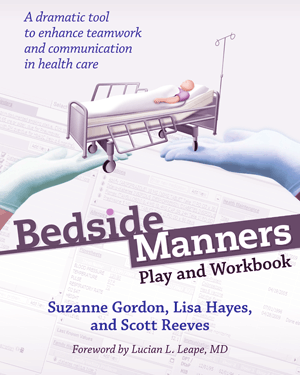
Used as an onstage reading with either professional actors or volunteer audience members, Bedside Manners is ideal for any venue. For students and professionals alike it provides insights into the range of emotions and behaviors experienced in a high-pressure, high-stress environment.
What Participants are Saying:
“Bedside Manners is a play for our times that challenges as it provokes. More fact than fiction, each of the twenty-one scenes is more compelling for being grounded in real-life encounters. Does drama dig deeper than role-play? Beyond question, yes, particularly when the parts are played by doctors and nurses who have opportunities to react and reflect afterward.”
–Hugh Barr, President CAIPE,
The UK Centre for the Advancement of Interprofessional Education
“Bedside Manners is a great tool for professional education and patient advocacy. Nurses and their organizations should find ways to use Bedside Manners to enhance the critical role of RNs on the health care team.”
–Julie Pinkham, RN, Executive Director
Massachusetts Nurses Association/National Nurses United
“This play stole the show at the National Patient Safety Foundation 15th Annual Patient Safety Congress. Hundreds of us were moved to tears by the everyday
reality that the play’s vignettes poignantly shed light on. The events depicted were
so amazing and engaging you could not make them up-–the playwright and patient
safety advocate journalist Suzanne Gordon and playwright Lisa Hayes based them
on actual published incidents and official error investigations. As a physician, it
was very humbling to have a look into this mirror and reflect on how we treat our
patients and each other.”
–Gordon Schiff, MD, Associate Director
Center for Patient Safety Research and Practice, Division of Internal Medicine, Harvard Medical School.
“Acting in Bedside Manners was transformative. When health care professionals and patients perform this play together, both they and their audience directly experience the impact that good – or poor – communication and teamwork have
on patient safety. As a patient advocate, I hope the health care community will
embrace this amazing teaching tool.
–Patty J. Skolnick, Founder and Executive Director
Citizens for Patient Safety
“I am not an actor and I have never been in a play. That all changed when I was assigned the role of Nurse 2. I was asked to read the script and prepare for rehearsal. After coaching and advice like, “Scoop the words off the page and send them into the audience” I went home and practiced my lines. I did not realize the significance of this play until we were on stage in front of our audience. It all clicked. We did not embarrass our characters or the authors. It was not only fun but I learned a lot.”
–Frank A. Rosinia, MD, Chairman
Department of Anesthesiology
Tulane University
“Bedside Manners makes a significant contribution by synthesizing a body of literature and presenting it as a play rather than an essay or lecture. It can be used for teaching not only medical and nursing students but also practitioners well into their careers, as it provides experiential as well as intellectual knowledge.”
–Robert L. Wears, MD, PhD
University of Florida, Imperial College London
“Bedside Manners – the 's' is important because this play within a book is about the relationships and interactions between health professionals… The workbook section is full of suggestions and practical tips for enhancing learning. This is a great addition to the library of interprofessional resources and a thought-provoking read for all health professionals and learners.”
–Jill E. Thistlethwaite, Professor of Medical Education
Director of the Centre for Medical Education Research and Scholarship
The Univeristy of Queensland School of Medicine, Australia
“Play acting is such a great way to engage otherwise reticent people in
the process of recognizing, discussing and effecting behavior change. It is a lot easier to do this if you are pretending to be someone else. The beauty of this approach is that the necessary messaging is actually planted in the heart and mind of the actor in a powerful and effective way, all while they think that they are someone else. Brilliant!”
–Terry R. Rogers, M.D., CEO
The Foundation for Health Care Quality
“Students in our Leadership Development for Health course performed Bedside Manners and it was a hit! Interprofessional teamwork is a concept that is taught throughout our program, but providing an avenue for experiential learning and dedicating time for discussion about the importance of communication between all team members, cemented these lessons. By also focusing on the patient’s perspective, the play sheds light on the fact that communication needs to improve for the safety of our patients. The message was powerful and deeply affected the students and faculty that attended.”
–Lisa Fidyk, MSN, MS, RN
Associate Program Director, Nursing Healthcare
Administration and Health Leadership Graduate Programs
University of Pennsylvania School of Nursing
“In an era when teamwork is the mantra of patient safety, the play Bedside Manners can help jump-start a long needed conversation about how doctors and nurses can collaborate rather than compete at the bedside. As a professor I have used the play Bedside Manners in my classes and it has certainly been an effective teaching tool that helps nurses think about how they can enhance teamwork and patient safety. As a teaching tool, the play creates an opportunity for honest and informative dialogue with students across the health care disciplines. The perspectives of nurse, physician, supervisor and family member are dramatized accurately and honestly. My students relished the opportunity to discuss issues of communication in high pressure and highly emotionally charged situations.”
–Kate McPhaul, PhD, MPH, RN, Assistant Professor,
Work and Health Research Center,
University of Maryland School of Nursing


